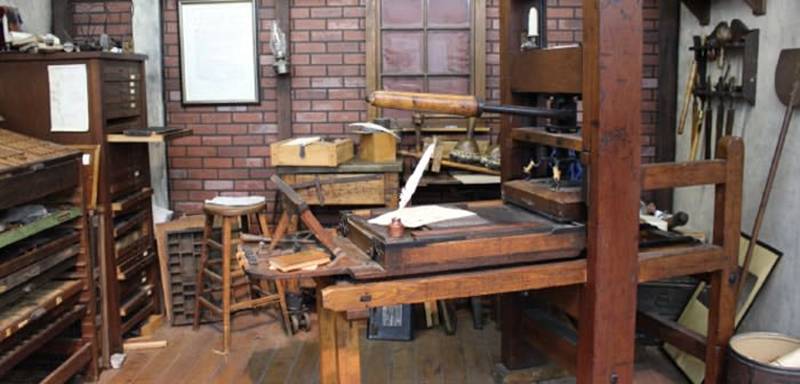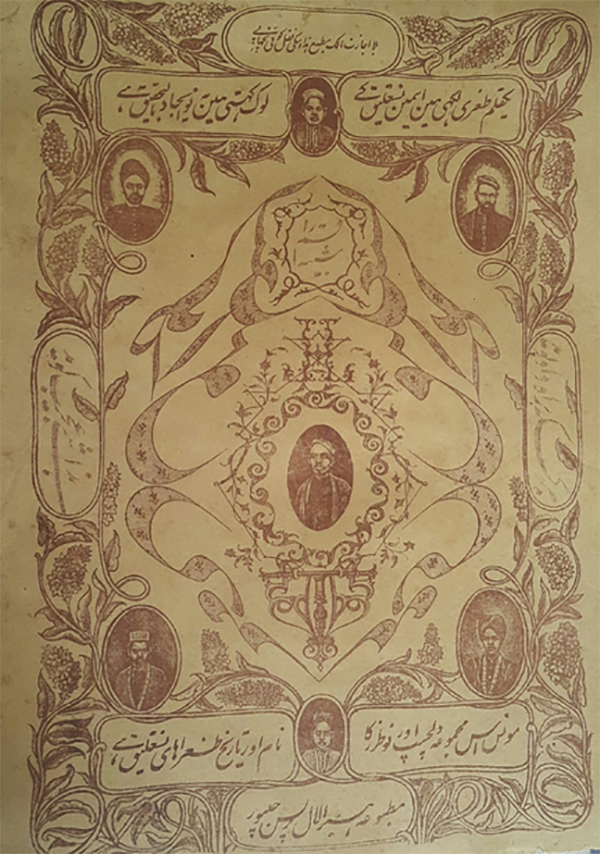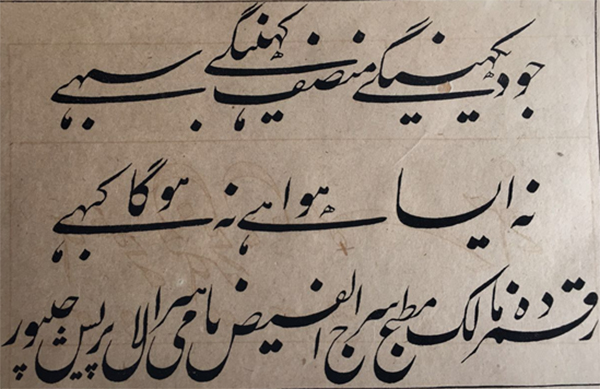
Jaipur, in the Sixth decade of the 19th century, experienced a sharp upswing in the quantum of literary transactions which saw the elites blending with the litterateurs, poets and scholars to augment the cause of art, literature, poetry and journalism. Under the auspices of Maharaja Sawai Ram Singh, a literary society, the first of its kind, was formed in city on 26th March 1869, whose inaugural conference witnessed the presence of the representative of the Governor General and Political agent among others. During the proceedings, it was decided that a rendezvous be convened after every fifteen days and a newspaper and printing press be initiated.
To accomplish the demands generated by the literary activities there was a burning necessity to inaugurate the printing presses and maintaining the same into contemplation, Hakeem Saleem Khan Khasta (editor of Neer Rajasthan – earliest Urdu weekly from Rajasthan) established the first press of Jaipur, Khawar-e-Rajasthan, in 1869, which later got rechristened as Society Press. It continued to operate until 1294 H (1877 AD); and Mirza Muhammad Ali Beg Mahwi worked as its last Manager. It was the same Mahwi who was a disciple of Maulana Imam Bakhsh Sahbai and had garnered accolades from the Persian and Urdu bard – Mirza Ghalib. The next press was founded in 1305 H (1887 AD) by Hira Lal Bhargav Monis (1853-1921) who named it Matba Siraj-ul-Faiz. This continued to work until 1932 and published books of Hira Lal, his brother (Panna Lal Nazim) and other authors. Bal Chandar Press at Kishan Pol Bazaar came up next which yielded lithographic products for some time. Subsequently, Jail Press was instituted on the campus of Jaipur Central Jail which initially employed extraordinary scribes like Muhammad Shareef and Abdul Qadir but afterward its excellence suffered a decline; the press was later renamed as Government Press. In 1333 H (1914 AD), Maulvi Asas-ud-deen Ahmad Tasneem started a press (Matba Maulvi Asas-ud-deen Waqe Shahr Jaipur) which became prominent as Qaumi Press, for it published the monthly journal Qaum which, in 1901, began publication under the editorship of Tasneem and survived until 1919. The printing press was functional until the demise of Maulvi Tasneem on 29th Muharram 1343 H (29th August 1924AD). He was such a connoisseur that he ran the enterprise for ten years despite the hardships. Hakeem Shamsuddin had set up a commercial press which published a handful of academic and literary books. Another concern, by the name of Begum Press, was set in motion but it ceased to exist before accomplishing anything laudable. Munshi Abdur Rahim, who was himself a calligrapher, had founded Rahimi Press but it collapsed soon for want of quality-works and resources. Muhammad Haneef had started Mashriq Press which also closed down in the absence of eminence of prints and promptness. In the year 1948, Babu Tikam Das Sindhi set up Shyam Litho Press which published only the lithographic yields but it lacked the printing-excellence.
The industry suffered in the wake of partition as a large chunk of Muslim elites including poets and journalists preferred to migrate to Pakistan.
It is an affair of grave concern that a minuscule amount of documentation is available on this subject and whatsoever information is available it is strewn across Persian and Urdu journals which are out of bounds for the general public. A committed research towards the theme would certainly unravel new vistas and reveal the hitherto concealed specifics.


To accomplish the demands generated by the literary activities there was a burning necessity to inaugurate the printing presses and maintaining the same into contemplation, Hakeem Saleem Khan Khasta (editor of Neer Rajasthan – earliest Urdu weekly from Rajasthan) established the first press of Jaipur, Khawar-e-Rajasthan, in 1869, which later got rechristened as Society Press. It continued to operate until 1294 H (1877 AD); and Mirza Muhammad Ali Beg Mahwi worked as its last Manager. It was the same Mahwi who was a disciple of Maulana Imam Bakhsh Sahbai and had garnered accolades from the Persian and Urdu bard – Mirza Ghalib. The next press was founded in 1305 H (1887 AD) by Hira Lal Bhargav Monis (1853-1921) who named it Matba Siraj-ul-Faiz. This continued to work until 1932 and published books of Hira Lal, his brother (Panna Lal Nazim) and other authors. Bal Chandar Press at Kishan Pol Bazaar came up next which yielded lithographic products for some time. Subsequently, Jail Press was instituted on the campus of Jaipur Central Jail which initially employed extraordinary scribes like Muhammad Shareef and Abdul Qadir but afterward its excellence suffered a decline; the press was later renamed as Government Press. In 1333 H (1914 AD), Maulvi Asas-ud-deen Ahmad Tasneem started a press (Matba Maulvi Asas-ud-deen Waqe Shahr Jaipur) which became prominent as Qaumi Press, for it published the monthly journal Qaum which, in 1901, began publication under the editorship of Tasneem and survived until 1919. The printing press was functional until the demise of Maulvi Tasneem on 29th Muharram 1343 H (29th August 1924AD). He was such a connoisseur that he ran the enterprise for ten years despite the hardships. Hakeem Shamsuddin had set up a commercial press which published a handful of academic and literary books. Another concern, by the name of Begum Press, was set in motion but it ceased to exist before accomplishing anything laudable. Munshi Abdur Rahim, who was himself a calligrapher, had founded Rahimi Press but it collapsed soon for want of quality-works and resources. Muhammad Haneef had started Mashriq Press which also closed down in the absence of eminence of prints and promptness. In the year 1948, Babu Tikam Das Sindhi set up Shyam Litho Press which published only the lithographic yields but it lacked the printing-excellence.
The industry suffered in the wake of partition as a large chunk of Muslim elites including poets and journalists preferred to migrate to Pakistan.
It is an affair of grave concern that a minuscule amount of documentation is available on this subject and whatsoever information is available it is strewn across Persian and Urdu journals which are out of bounds for the general public. A committed research towards the theme would certainly unravel new vistas and reveal the hitherto concealed specifics.


A calligraphic specimen printed at Matba Siraj-ul-Faiz alias Hira Lal Press
